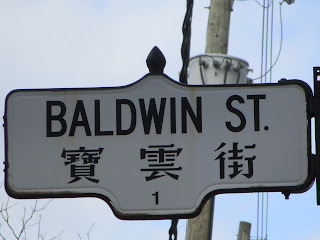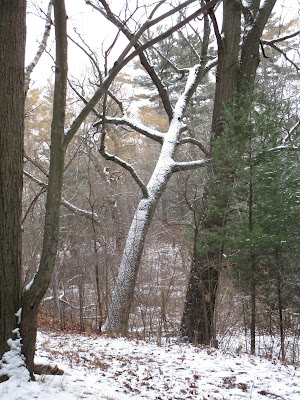I remember reading once about a guy whose life needs included “hobbies at which I’m a rank amateur, to keep me honest.” Just after my forty-sixth birthday I played in my first football game—at least with more than a few players, and on a field. I blocked a little, didn’t throw except in warmup, dropped almost every pass. But if you thought I was bad at football, you should hear me speak Spanish.
 |
| Maybe I'll try baseball next time. |
Spanish exists in order to make me feel like I speak French by comparison. Seriously, I first studied Spanish when I was in sixth grade, but having never spent significant time in a Spanish-speaking country, my lack of practice makes for very imperfect. So since we got to Toronto I’ve been back at the Spanish Centre, taking elementary lessons. Again. This past week our teacher, Carla from Caracas, played us some audio we’d listened to at the beginning of the course, just to show that we are able to understand a little more than a few months ago!
We had returned from our few days in the U.S. through the Seneca Nation, proudly signed as “sovereign land since time immemorial.” This was a good introduction to the site I visited on the last day of 2018, historic Fort York. The fort predates the modern city of Toronto and was once on the lakeshore, before the lakeshore was moved. During the battle here more than 200 years ago, many First Nations warriors fought on the side of the British, to resist the invading United States.
Of course when I was growing up in the U.S., I read that the War of 1812 was an attempt by Britain to retake its American colonies. It’s illuminating to think that the U.S., and the country that became Canada, once fought on opposite sides, and have opposite views of history. I don’t remember reading anything, for example, about the (relative) rights over their own lands that indigenous people had under British rule, which caused them to resist the U.S.
I learned at Fort York that tensions between U.S. and British North America continued through the U.S. Civil War and even after, as Irish Fenians struck a blow for their independence at Canada! And lest anyone think that modern warfare is uniquely hideous or brutal, a surgeon on duty at the Battle of York left this sobering account.
On T’s and my first visit back to Canada, in 2012, we had the pleasure of touring several War of 1812 sites. It was the war’s bicentennial, and my writing buddy Andrejs’s wife, Bonnie, was a history buff. So we enjoyed that part of our visit almost as much as Andrejs showing us Niagara wine country!
Sadly, Bonnie has since passed away, and I was afraid I’d lost touch with Andrejs. So what a nice surprise it was, at Christmas, to hear from him and arrange lunch together before we left Ontario. T. and I had so much fun catching up with Andrejs that we forgot to take any pictures—so here’s one of my writing group, in an earlier incarnation. It’s the last meeting we had while I was still a resident of Canada.
 The last meeting of my stay this time takes place on Sunday, so Epiphany was my last Sunday at the Church of the Holy Trinity. The doors of the church were blessed, and we were each given a piece of blessed chalk. Marty, last seen giving instructions for the hot chocolate, assured me that the chalk was “internationally blessed,” so I can take it back to England or wherever I go. Let’s hope it doesn’t crumble into suspicious powder along the way (fortunately, it’s blue!)
The last meeting of my stay this time takes place on Sunday, so Epiphany was my last Sunday at the Church of the Holy Trinity. The doors of the church were blessed, and we were each given a piece of blessed chalk. Marty, last seen giving instructions for the hot chocolate, assured me that the chalk was “internationally blessed,” so I can take it back to England or wherever I go. Let’s hope it doesn’t crumble into suspicious powder along the way (fortunately, it’s blue!)
All these lasts were starting to make me blue. I thought we’d been in “our” neighbourhood for the last time, but T. had another appointment with the audiologist on Roncesvalles, so I met her afterwards for lunch. We went to the Cafe Polonez, a place we’d always meant to try, but never did while we were living there. The borscht with dumplings was delicious. Another meal we enjoyed was at The Winding Road, a Chinese place in Baldwin Village. Back when I lived around the corner, I’d always wanted to eat on this charming little strip of Baldwin Street, but of course, I never had.
 Our last week in town we were back at Wayne and Jay’s. There was plenty of visiting with them and revisiting other friends. Marie-Josée and Olivier took us to lunch at the University of Toronto Faculty Club. We were lucky to be joined this time by Monique, another former co-worker whom we’d have missed otherwise. Could barely recognize her in her winter gear, though—it was cold!
Our last week in town we were back at Wayne and Jay’s. There was plenty of visiting with them and revisiting other friends. Marie-Josée and Olivier took us to lunch at the University of Toronto Faculty Club. We were lucky to be joined this time by Monique, another former co-worker whom we’d have missed otherwise. Could barely recognize her in her winter gear, though—it was cold!
But mostly, I just walked. I took advantage of the mildest day (rain!) to walk through Greektown on the Danforth, and through Riverdale Park. On a wintry day this is a great place to sled. (“Tobogganing” is what it’s called here, although when I was growing up I heard woolly winter hats called toboggans. In Canada, a wool or fleece hat is called a toque.)
Then I took the ferry over to Ward’s Island.
The Toronto Islands have a totally different feel in winter. On the beach side you can forget the city is even there, and at times, it felt like I was the only person on the island at all.
 |
| Boardwalk to Centre Island |
Just then, it started to snow. I walked down to Balmy Beach but it was not balmy, so I made my way back west and down to Kew Beach. Couldn’t see much for the snow, except for children enjoying themselves.
Readers may remember a picture of T. and me in northern Manitoba, wearing everything we possessed (at least, I had on a balaclava). I want to point out that in that picture the wind chill was -20 C (-4 F)—the temperature down to which, in Canada, children are supposed to play outside.
I even ventured back to the neighbourhood of “the flophouse,” where I never expected to live for two years. It was worth it to visit with colleagues from my last job in Toronto.
We, or I, have explored most of what I wanted to while we were in Toronto, but a lot of cuisine remains untried. That’s probably because we so enjoyed having our own place and being able to cook in it—going out to eat loses much of its appeal when you have to do it, traveling. That’s okay. We will be back.
The last day I walked a Toronto neighborhood, it was bright and sunny, but very cold. This is the type of winter day I actually love. (Weird, I know.) Anyway, three images will remain with me from this city. I was walking along Corso Italia and stopped to take a picture of a Jamaican restaurant. A cheery guy beamed and waved at me through the window. Afterwards I boarded the streetcar with some Orthodox Jewish boys wearing ritual fringes. Then there was this bad selfie I took at the basketball game, inadvertently capturing the two young women in headscarves who filled in the last seats next to us.
Geez, I'm going to miss this place.
Geez, I'm going to miss this place.
Now there is only one continent left of the traditional six we mean to visit, and it’s mostly Spanish speaking. One of the first questions one learns how to answer is ¿De dónde eres? Where are you from? And there are two ways to answer. I can say Soy de los Estados Unidos, I am from the United States. But one can also answer a nationality question like the Molson ad says: “I am Canadian.”
 |
| Where it all began |
I could say Soy norteamericana. As far as Spanish is concerned, everyone from the western hemisphere is from the Americas. But doesn’t North American include Canadian too? I can’t really claim to be “from” Canada, and I know by the time we fly I will be ready to move on; but I’ll do so knowing, more than ever, that I’m as canadiense as anyone else with this passport.

















2 comments:
A fine farewell to Toronto, beginning with the humorous, "Spanish exists in order to make me feel I speak French by comparison," and ending with the touching, "I know by the time we fly I will be ready to move on; but I’ll do so knowing, more than ever, that I’m as canadiense as anyone else with this passport." Travel safely and well! G & P
Hello there! This blog post couldn't be written much
better! Going through this post reminds me of my previous roommate!
He always kept talking about this. I am going to forward this post
to him. Pretty sure he will have a very good read.
Thanks for sharing!
Post a Comment